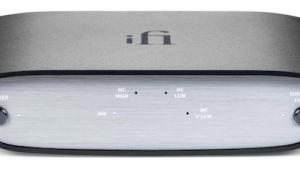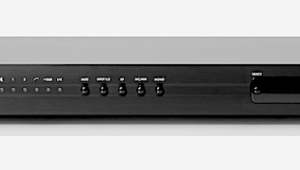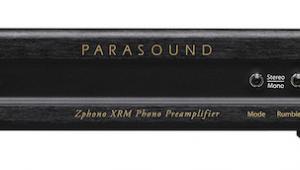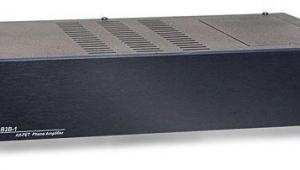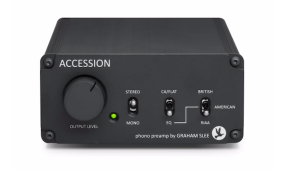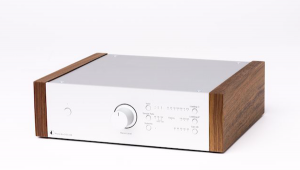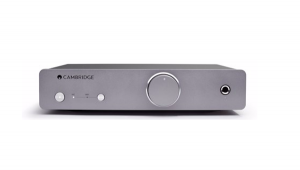Michael, I know it's apples versus oranges, but that's real life after all. Having now auditioned both the JC-3 and the Manley Chinook, how would you constrast the two? I'm not asking you to tell which one is better, just help me to understand how they are different. If context helps, I have a VPI Classic 3 with Te Kaitora Rua and listen to jazz with some classic rock and indie thrown in. Classical when in a mood. Favorite albums include (the Tone Float) In Absentia, Jazz at the Pawnshop, Into the Labyrinth. Looking to upgrade the phono stage of my Perseus Magnum ... intrigued by staying tubey but addicted to macrodynamics.
Parasound Halo JC 3 phono preamplifier

Designer John Curl decided to keep the JC 3's design simple by choosing purity over adjustability. Therefore, the loading for moving-coil cartridges is limited to 100 ohms or 47k ohms, with 47k ohms also for the moving-magnet input. Curl believes that the vast majority of MC cartridges are suited for 100 ohm loading, and I concur. If you don't like that, leave it wide open at 47k, which I believe is almost never correct. Changing the loading is done via custom-made NKK selector switches with gold-on-silver contacts.
Schram understood that the limited loading options might lose him some customers, but he let Curl call the shots. Why? For you youngsters, I quote Stereophile's founder, the late J. Gordon Holt, who in 1988 wrote that "Few people in the audio business would deny that John Curl is an audio design genius—arguably the greatest one of our generation. He designed and built the electronics for Mobile Fidelity's SuperMaster and David Wilson's (of Wilson Audio) UltraMaster tape recorders, two of the three best analog recorders in the world. (The other is Keith Johnson's home-brew unit.) He designed the JC-1 head amp and JC-2 preamplifier sold under the Mark Levinson name some years ago." Curl's Vendetta Research SCP-2 is still considered by many, including Stereophile's Bob Reina, the classic modern-day phono preamp against which all others should be measured.
Schram says the passive parts used in the JC 3's RIAA equalization circuit are identical to those used in the Vendetta, which cost $3000 in 1992. The circuit uses active parts chosen for both their very low levels of noise and the spectrum of that noise, which Schram says is critical to how we perceive noise. The circuit is fully direct coupled using a DC servo—there are no coupling caps in the signal path—and the output stage is a true dual-differential, balanced design.
The Vendetta was "about 10dB quieter" than the JC 3, but the FETs used in the older design are no longer available. That hardly matters: the Vendetta was designed for use with the Ortofon MC cartridges of its era, which output only 0.05mV. Today, most MCs produce 10 times that.
The power supplies, using an R-core transformer that Schram says rejects more AC "crud" than does a toroid, are modeled on the design and layout of the JC 2—according to Schram, one of the quietest line stages ever made. Two low partitions of carbon steel isolate the transformer from the phono-circuit modules. The power supply also has a large inductor and ultrafast, soft-recovery diodes. Each gain/EQ module is housed in its own internal enclosure of extruded aluminum. The JC 3 has a built-in AC line conditioner, as well as a switch to invert the AC polarity, which can be useful in eliminating ground hum.
A Mono/Stereo switch on the front panel activates relays within each channel's gain/EQ module. When the switch is set to Stereo, each channel's signal remains within that channel's housing. The signals meet each other outside the shielded housing only in Mono mode. The JC 3's gain is 47dB (MM) or 68dB (MC), and its signal/noise ratio for MC cartridges is 75dB input shorted, IHF A-weighted.
A Closer Listen
Of the four phono preamps I review this month, the Pass Labs XP-25 had the deepest, tightest bottom end. The Parasound JC 3's bass was also tight and punchy, and came very close, but it couldn't dig to the very bottom, where the XP-25 did go when the music called for it—as the Big Joe Turner track "Down Home Blues," from Kansas City Here I Come (LP, Pablo 2310 904, recorded by Allen Sides at Ocean Way in 1984) did.
The JC 3's midbass attack was timbrally and texturally ideal—for instance, with "Green Shirt"'s rolling bass lines (from a superb reissue of Elvis Costello's Armed Forces, LP, Mobile Fidelity Sound Lab MFSL 1-331). But dynamically, while performing well beyond its price, it couldn't compare with the XP-25—or, at more than ten times the price, the Ypsilon VPS-100. I compared the $2350 JC 3 with the three far more expensive phono preamps only because it's good enough to play on the same field. That's not the same as winning, but it's still impressive.
At the other end of the price spectrum, the Parasound JC 3 was identifiably less extended on top compared to the Pass XP-25, which, until it was broken in, seemed to have a "crispy" lift in the top octaves.
When, without paying particular attention, I switched among the versions I'd recorded of "Everybody Knows This Is Nowhere." from Neil Young and Crazy Horse's At the Fillmore 1970 (LP, Reprise 44429-1) with these four phono preamps, all of them sounded good. But when I paid close attention, I heard more cymbal shimmer, bass solidity, and definition from the Ypsilon VPS-100 and Pass XP-25. The Parasound JC 3 tucked it in ever so slightly at both ends of the audioband, losing some shimmer on top and punch on the bottom, while the Allnic H-3000V produced some shimmer but lost out in bottom-end definition, image focus, and "snare crack" in favor of spatial opulence.

I heard more upper-midrange air and spaciousness from the two tubed models, but the Allnic really pushed forward a big bubble of sound that sounded more like a ringing coloration than something actually in the recordings. I could really hear this with Tina Brooks' True Blue (LP, Blue Note/Music Matters MMBST 84041; the input resistance and transformer input turns were both set correctly to 30 ohm loading for the Ortofon A90.) When Brooks' tenor sax and Freddie Hubbard's trumpet both blare the main theme, instruments lost focus and solidity and began to bloom, with a slight haze forming around them on the higher and louder notes. Both instruments announce the theme in unison and then stop, which hangs the artificial reverb out in the pause for a millisecond. Then the horns repeat the theme. In that pause, the Allnic's slower reaction time somewhat obscured the reverb.
When I switched to the JC 3, I lost some of the trumpet's brassiness and the sax's reediness, but the images remained extremely well focused, timbrally and spatially, as the two instruments ascended. When they stopped, the reverb was well defined in the ensuing pause. The JC 3 had superb musical grip and control, especially for its price.
Mikey Sums Up
At $2350, the Parasound JC 3 is a remarkably fine phono preamp that easily held its own against the far costlier competition. Its minor shortcomings were at the extremes of frequency response, dynamics, and timbral verisimilitude; the centers held firm. In other words, unless you're running full-range, ultradynamic speakers, you won't miss what the JC 3 hasn't got to give—and even then, I can confidently say that the JC 3 represents the best current value in a phono preamp that I know of, as long as you can live with the limitation of a choice of only two loadings, 100 and 47k ohms. Highly recommended! —Michael Fremer
- Log in or register to post comments






